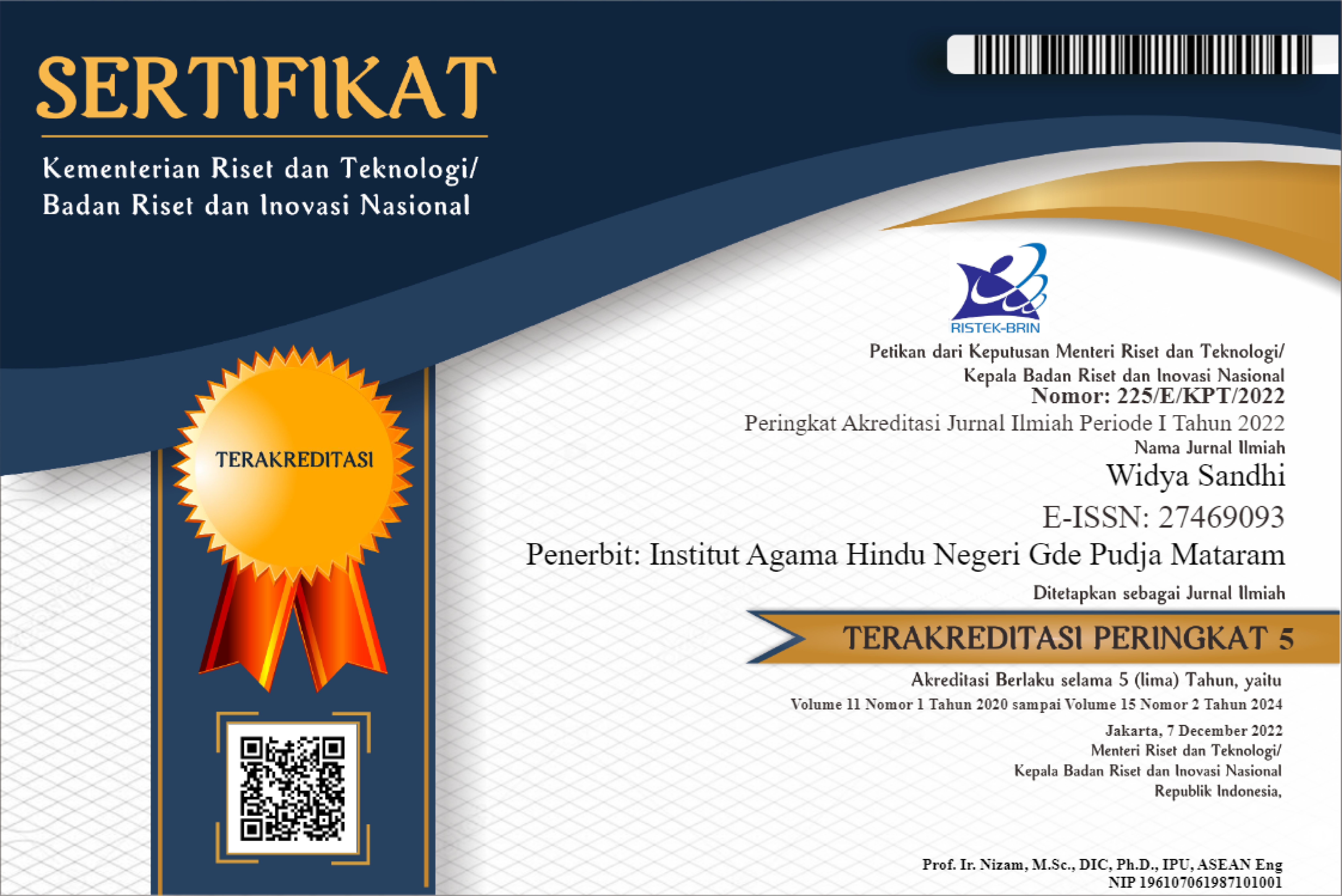Keris Sebagai Representatif Manusia Dalam Peradaban Masyarakat Bali Di Lombok
Abstract
Keris, a traditional Indonesian weapon, plays a significant role in the civilization of the Balinese society in Lombok. Keris is not merely a weapon but also a symbol of culture, art, philosophy, and identity for the Balinese community. In this article, we explore the role of keris as a representative of humanity in the civilization of the Balinese society in Lombok. This research adopts a qualitative method, conducting field studies and interviews with community figures who possess extensive knowledge and experience regarding the Balinese keris in Lombok. The research findings indicate that the keris holds profound meaning for the Balinese society in Lombok. Firstly, the keris symbolizes a strong cultural identity. The keris serves as a marker of social status and bravery within the Balinese society. Owners of the keris are considered to have high standing and are respected by the community. Through the keris, the Balinese society in Lombok preserves and passes down their cultural values from generation to generation. The keris also represents the beauty of art. The process of crafting a keris involves high-level skills from the keris makers. The Balinese keris in Lombok features exquisite adornments, including intricate carvings and unique Balinese ornaments. The artistic beauty of the keris serves as an expression of the Balinese community's creativity. In conclusion, the keris holds significant meaning as a cultural symbol and an artistic expression for the Balinese society in Lombok. It represents their cultural identity, social status, bravery, and artistic creativity. This research sheds light on the profound role of the keris as a representative of humanity within the civilization of the Balinese society in Lombok.
References
Ardhana, I. W. G., & Laksmi, N. K. D. P. (2013). "Pentingnya Seni Keris dalam Perkembangan Budaya Masyarakat Bali di Lombok." Jurnal Ilmiah Pariwisata, 17(2), 129-138.
Ardika, I. W. (2017). Keris Bali di Lombok: Representasi Budaya Bali dalam Konteks Multikulturalisme. Jurnal Pendidikan Bahasa dan Sastra, 17(2), 144-156.
Atmaja, I. G. A. A. (2014). Sejarah Keris Bali: Dari Bali menuju Lombok. Surya Bhumi, 2(2), 199-214.
Blustein, R. J. (2000). Representing Human Values in the Cultural Domain. Journal of Applied Developmental Psychology, 21(1), 85-96.
Dewi, I. A. K., & Dwipayanti, N. M. (2017). Pengaruh Perilaku Kultural terhadap Kualitas Hidup pada Masyarakat Bali di Kabupaten Gianyar. Jurnal Ilmiah Psikologi, 6(1), 57-68.
Fitriani, E. (2019). Budaya Keris sebagai Peningkat Kualitas Hidup Masyarakat Solo dan Surakarta. Jurnal Ipteks Terapan, 13(2), 116-126.
Hardjasaputra, S. (1996). Filosofi Keris Jawa: Tinjauan Etnografi dan Psikologi Budaya. Jakarta: Balai Pustaka.
Henley, D. (2009). Masyarakat Bali di Lombok dan Representasi Identitas Budaya. Jurnal Sosial Humaniora, 2(3), 141-160.
Hinzler, H. I. R. (1997). "Keris and other Malay weapons." Oxford University Press.
Hinzler, H. I. R. (2013). The Balinese Keris: A Historical Perspective. Archipel, 85(1), 175-202. Prabawa, W. A. (2015). Keris Sebagai Simbol Identitas Budaya Bali di Lombok. Kajian Bali, 5(1), 97-118.
Irmayanti, I. A. P., & Adnyani, I. G. A. K. (2021). Representation of Keris as a Cultural Symbol in Balinese Society in Lombok. International Journal of Linguistics, Literature, and Culture, 7(1), 27-34.
Laksana, I. K., & Artika, I. M. (2018). Pemahaman Filsafat Hidup Bali Lombok melalui Keris. Jurnal Filsafat, 28(2), 146-157.
Noer, D. (1987). Keris dan Kehidupan Masyarakat. Jakarta: Penerbit Djambatan.
Nugroho, D. (2018). Kearifan Lokal Keris sebagai Peningkatan Kualitas Hidup Masyarakat Yogyakarta. Jurnal Ilmiah Universitas Batanghari Jambi, 18(1), 24-32.
Nuraini, F., Mawardi, I., & Susilawati, L. (2017). Penerapan Kearifan Lokal Masyarakat Palembang sebagai Peningkatan Kualitas Hidup. Jurnal Kependidikan: Penelitian Inovasi Pembelajaran, 1(1), 69-79.
Pratama, I. G. B., & Sukanta, I. M. (2019). Keris sebagai Identitas Budaya Masyarakat Bali di Lombok. Jurnal Pendidikan Humaniora, 7(3), 272-284.
Prasita, I. M. N., & Sari, I. A. P. (2018). Representasi Simbol Keris dalam Budaya Bali di Lombok. Jurnal Sospol, 4(1), 17-28.
Priyanto, Y. B., & Suryadi, I. (2019). Fungsi dan Makna Keris dalam Budaya Bali di Lombok. Jurnal Antropologi: Isu-Isu Sosial Budaya, 21(2), 176-191.
Santoso, B., Rahmawati, A., & Pratama, S. P. (2018). Keris sebagai Representasi Budaya Jawa dalam Peningkatan Kualitas Hidup Masyarakat Yogyakarta. Jurnal Pembangunan Wilayah dan Kota, 14(3), 241-250.
Subiyanto, D. (2017). The Cultural Meaning of Keris in Javanese Society. International Journal of Cultural Studies, 2(2), 53-66.
Soekmono, R. (1984). "Keris dan Budaya Jawa." Kanisius.
Suprapto, R. (2008). "Keris dan Kepercayaan Masyarakat Bali." Mimbar Hukum, 20(3), 439-452.
Sedana, I. W. (2015). Keris dalam Kearifan Lokal Masyarakat Bali di Lombok. Journal of Cultural Studies, 15(2), 224-244.
Suarta, I. G., & Wirawan, I. M. (2020). Kekerisan dalam Kehidupan Masyarakat Bali di Lombok. KERTHAYASA: Journal of Social and Cultural Anthropology, 2(1), 27-43.
Widiastuti, N. P. A. (2018). Keris Sebagai Lambang Identitas Budaya Bali di Lombok. Jurnal Bina Praja: Journal of Home Affairs Governance, 10(1), 35-44.
Yasa, I. M., Sutajaya, I. M., & Suja, I. W. (2022). Kris Sacred Art Which Has Parhyangan Value Based on Sundaram's Satyam Siwam. Proceedings of the 1st International Conference on Social Science and Technology (INCOSST) (pp. 1-14). Cirebon: Ridwan Institute.

This work is licensed under a Creative Commons Attribution-NonCommercial-ShareAlike 4.0 International License.
Authors who publish with this journal agree to the following terms:
- Authors retain copyright and grant the journal right of first publication with the work simultaneously licensed under a Creative Commons Attribution-ShareAlike 4.0 International License. that allows others to share the work with an acknowledgment of the work's authorship and initial publication in this journal.
- Authors are able to enter into separate, additional contractual arrangements for the non-exclusive distribution of the journal's published version of the work (e.g., post it to an institutional repository or publish it in a book), with an acknowledgment of its initial publication in this journal.
- Authors are permitted and encouraged to post their work online (e.g., in institutional repositories or on their website) prior to and during the submission process, as it can lead to productive exchanges, as well as earlier and greater citation of published work (See The Effect of Open Access).






.jpg)




